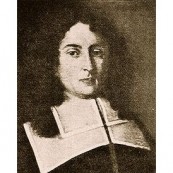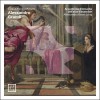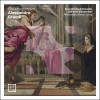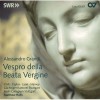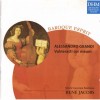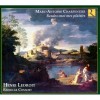Composers
Alessandro Grandi (1586 – after June 1630, but in that year) was a northern Italian composer of the early Baroque era, writing in the new concertato style. He was one of the most inventive, influential and popular composers of the time, probably second only to Monteverdi in northern Italy.
He was probably born in Ferrara and spent the first part of his life there, likely studying with Giovanni Gabrieli at Venice, which was nearby. He held several posts in Ferrara as maestro di cappella at different cathedrals and academies. In 1617 he won a post at St. Mark's in Venice, during the time Monteverdi was choirmaster there. Eventually he became Monteverdi's assistant, and during this time seems to have chosen to write works in some of the smaller forms which Monteverdi was neglecting. In 1627 he went to Bergamo, probably because he had an opportunity to be maestro di cappella at a place where he could build up the music program from scratch. Most likely he met Heinrich Schütz on that composer's second visit to Italy. Unfortunately, after only three years at Bergamo, Grandi died in 1630 during an outbreak of the plague.
Most of his music is vocal with instrumental accompaniment. Stylistically, his early music is similar to that of Giovanni Gabrieli, with alternating short passages of greatly contrasting rhythms and texture; however he usually wrote for smaller forces. Most of his early compositions are motets in the concertato style: some are duets and trios, an innovation in motet writing, which usually involved larger groups. Grandi was one of the few composers who continued to write involved vocal polyphony over the basso continuo right after its introduction—most composers using the continuo in the first decades of the 17th century wrote monodies, or preferred more homophonic textures.
Grandi experimented with extreme emotionalism in some of his music, with chromaticism, ornament and affectation; while harmonically he was not as adventurous as Gesualdo, he was connected to the larger tradition, and thus his works were almost as influential as Monteverdi's. He ceaselessly innovated, writing monodies with instruments such as violins, and in a sectional form with repeating parts for instruments only—an idea which would develop into the ritornello. The music of Grandi shows a link between the concertato style which began the Baroque era, and the form of the cantata which culminated in the work of J.S. Bach.
Grandi was one of the most popular composers of his day; his works were published throughout Italy, Germany, and the Low Countries, and continued to be reprinted long after his death. He wrote motets, psalm settings, madrigals, as well as some of the earliest compositions to be called "cantata."
Recently Added
Biography
Alessandro Grandi (1586 – after June 1630, but in that year) was a northern Italian composer of the early Baroque era, writing in the new concertato style. He was one of the most inventive, influential and popular composers of the time, probably second only to Monteverdi in northern Italy.
He was probably born in Ferrara and spent the first part of his life there, likely studying with Giovanni Gabrieli at Venice, which was nearby. He held several posts in Ferrara as maestro di cappella at different cathedrals and academies. In 1617 he won a post at St. Mark's in Venice, during the time Monteverdi was choirmaster there. Eventually he became Monteverdi's assistant, and during this time seems to have chosen to write works in some of the smaller forms which Monteverdi was neglecting. In 1627 he went to Bergamo, probably because he had an opportunity to be maestro di cappella at a place where he could build up the music program from scratch. Most likely he met Heinrich Schütz on that composer's second visit to Italy. Unfortunately, after only three years at Bergamo, Grandi died in 1630 during an outbreak of the plague.
Most of his music is vocal with instrumental accompaniment. Stylistically, his early music is similar to that of Giovanni Gabrieli, with alternating short passages of greatly contrasting rhythms and texture; however he usually wrote for smaller forces. Most of his early compositions are motets in the concertato style: some are duets and trios, an innovation in motet writing, which usually involved larger groups. Grandi was one of the few composers who continued to write involved vocal polyphony over the basso continuo right after its introduction—most composers using the continuo in the first decades of the 17th century wrote monodies, or preferred more homophonic textures.
Grandi experimented with extreme emotionalism in some of his music, with chromaticism, ornament and affectation; while harmonically he was not as adventurous as Gesualdo, he was connected to the larger tradition, and thus his works were almost as influential as Monteverdi's. He ceaselessly innovated, writing monodies with instruments such as violins, and in a sectional form with repeating parts for instruments only—an idea which would develop into the ritornello. The music of Grandi shows a link between the concertato style which began the Baroque era, and the form of the cantata which culminated in the work of J.S. Bach.
Grandi was one of the most popular composers of his day; his works were published throughout Italy, Germany, and the Low Countries, and continued to be reprinted long after his death. He wrote motets, psalm settings, madrigals, as well as some of the earliest compositions to be called "cantata."
